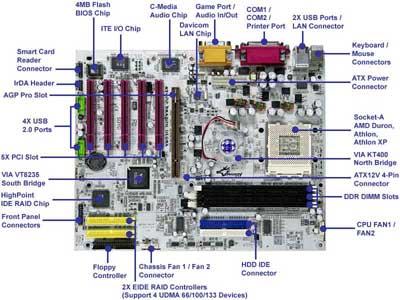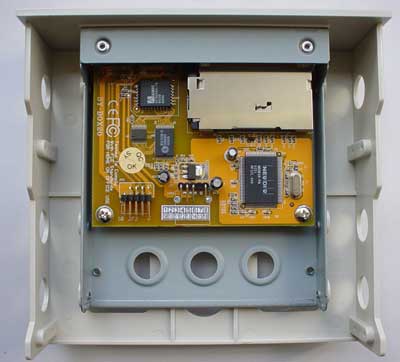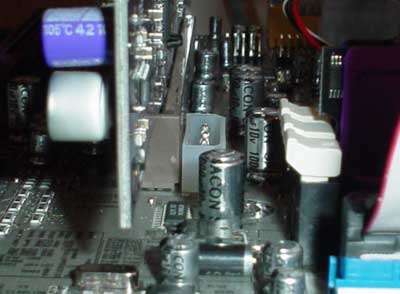
Original Link: https://www.anandtech.com/show/1001
Soyo KT400 DRAGON Ultra Platinum Edition: Full-Featured KT400
by Evan Lieb on September 27, 2002 2:40 AM EST- Posted in
- Motherboards
Soyo continues to push into the high-end of the motherboard market with its DRAGON line of products. Whether it was their 645DX or P4X400 motherboards, Soyo has been pursuing the high-end market for a while now, and for several good reasons.
The first reason is simple; Soyo's a business, and like any other business they want to build up as much capital as possible. Therefore, Soyo has focused a good portion of their business strategy towards producing top-of-the-line (i.e. expensive) motherboards. This move couldn't apply better to the Soyo KT400 Ultra. This is where the second reason comes into play; the KT400 Ultra series symbolizes yet another attempt by Soyo to gain a reputable name as a motherboard maker. So far we they've done a bang-up job with their DRAGON series of motherboards, and it's fairly evident that their efforts have proven successful so far, as more and more enthusiasts are taking their motherboards seriously. Soon enough, Soyo might be considered a serious threat to top-tier motherboard makers like ASUS, MSI, and Gigabyte.
But for now, Soyo has to battle it out in the increasingly cutthroat desktop motherboard industry. Read on to see how Soyos' latest incarnation (the Soyo KT400 DRAGON Ultra) fares against the competition.
Soyo KT400 DRAGON Ultra: Basic Features
|
Motherboard Specifications |
|
|
CPU
Interface
|
Socket-462
|
|
Chipset
|
VIA
KT400 North Bridge
VIA VT8235 South Bridge |
|
Bus
Speeds
|
100
- 255MHz (in 1MHz increments)
|
|
Core
Voltages Supported
|
up
to 1.85V (in 0.025V increments)
|
|
I/O
Voltages Supported
|
N/A
|
|
DRAM
Voltages Supported
|
up
to 2.8V in 0.1V increments
|
|
Memory
Slots
|
3
184-pin DDR DIMM Slots
|
|
Expansion
Slots
|
1
AGP 8X Slot
5 PCI Slots |
|
Onboard
RAID
|
Highpoint
HPT372
|
|
Onboard
USB 2.0/IEEE-1394
|
USB2
Supported through South Bridge
|
|
Onboard
LAN
|
Davicom
DM9161 10/100
|
|
Onboard
Audio
|
C-Media
CMI8738 6-channel audio
|
Soyo's KT400 board comes with lots of features in addition to some really neat accessories.
We'll start off with the onboard RAID chip that's a part of the Soyo KT400 DRAGON Ultra. Soyo decided to opt for the HighPoint 372 chip, which supports RAID 0, 1, and 0+1 arrays. This chip is actually ATA133 compatible, so you'll be able to take advantage of any ATA133 drives if you like.
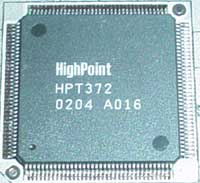 |
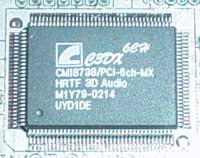 |
Soyo also decided to include a C-Media CMI8738 sound chip. Currently, this is one of the higher quality onboard sound solutions available on the market. In our KT400 roundup, we'll be sure to test the output quality of all KT400-based motherboards with onboard sound. As we did in our KT333 roundup in June, we'll be using RightMark's Audio Analyzer, since we believe it's a very objective way of measuring sound quality, and what to look for in an onboard sound solution like the C-media CMI8738.
One of the most interesting features the KT400 Ultra brings to the table is support for DDR400 memory (3 DIMM slots available). Of course, like most unofficial DDR400 motherboards, there's either very little performance boost, none at all, or even less performance with DDR400 (we'll get into the KT400 Ultra's DDR400 performance later on). As we covered in our ASUS A7V8X and ECS L7VTA reviews, the KT400 chipset also brings AGP 8X to the table. We'll be doing AGP 8X compatibility testing using NVIDIA's new 8X cards as well as the Radeon 9700 and SiS Xabre in an upcoming roundup, so be sure to check back for the results of that comparison.
It's worth mentioning of course that you get native USB 2.0 support with this KT400-based motherboard. Although not a very useful feature, Soyo has implemented a unique color scheme with their KT400 Ultra; the PCB is colored an intriguing silver/platinum color, which is the reason this board is part of Soyo's Platinum Edition series. The 5 PCI slots are colored purple, the RAID connectors are colored yellow (which is norm for RAID connectors currently), and the on-board USB 2.0 headers are colored green.
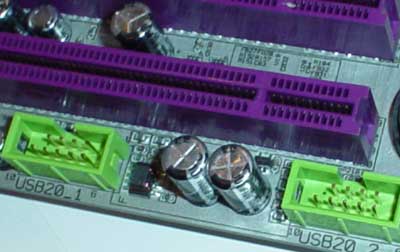
We also see that Soyo went with active cooling for the KT400 North Bridge. As we mentioned in our KT400 reviews, active cooling isn't the greatest idea if you desire an absolutely silent system with no chance of North Bridge fan failure (OEMs especially don't usually like lots of moving parts, active North Bridge fans included). However, we must concede that active cooling over a North Bridge is a good idea if you're overclocking, as the additional cooling can aid in system stability.

Finally, we have the I/O panel, which includes the usual legacy features (2 parallel ports, 2 serial ports, a Game Port, and 2 PS/2 ports) in addition to 2 USB 2.0 ports and a regular 10/100 Ethernet port.
Another nice accessory Soyo bundles is a Serial ATA riser card. Powered by Marvell's 88i8030 chip, this riser card is able to convert the parallel ports on the motherboard to Serial ATA ports for use with Serial ATA drives. Note that this is not a native Serial ATA interface but instead performs a Parallel-to-Serial translation which will result in some overhead. Soyo claims that there's no performance loss as a result of this but we'll leave that up to our performance tests once Serial ATA drives become readily available.
Thankfully, the Soyo KT400 Ultra also comes with lots of goodies in addition to the solid feature-set we just described. These accessories include a Sigma Box (fits in a 5.25" or 3.5" drive bay, see below) featuring a smart card reader slot and 2 USB 2.0 ports, SPDIF Audio Card, heatsink compound, I/O panel, 3 ATA cables, and extra software (includes Norton AntiVirus 2002, Norton Ghost, Adobe Active Share, Adobe Acrobat Reader, Vcom Autosave, WinDVD, Ewalla Text & Voice Messaging, and Imagemore Photographic Collection). All in all, we got to hand to Soyo, they put together some quality accessories in addition to good software.
Board Layout
The Soyo KT400 Ultra was well laid for the most part. We only had one or two minor complaints to report.
We were happy to see Soyo leave enough space between the DIMM connectors and AGP slot so that we were allowed to uninstall memory without having to uninstall the video card. There are an excessive amount of motherboard makers that leave little or no space between the DIMM connectors and the AGP slot, so we're glad to see Soyo break that trend.
The Primary/Secondary IDE connectors and RAID connectors are located on the outskirts of the motherboard this time. These connectors are positioned well enough so that there's just enough space to maneuver the IDE cables to the sides of an ATX case, where they won't obstruct the users' path.
Disappointingly, Soyo positions the ATX (20-pin) connector all the way on the opposite side of the motherboard, right next to the I/O ports. This is most unfortunate, as it becomes very difficult to add/remove items in ones' case with an array of ATX cables hampering your way. Perhaps next time around they'll change this.
Soyo also places two green USB 2.0 connectors just below the last PCI slot. This is clearly the best spot to position these connectors, as you don't have to manipulate any wires across the motherboard (too many USB headers are placed towards the center of the motherboard these days, which makes it difficult to clear the wires away from the middle of the case).
A somewhat nagging issue was the positioning of the CPU lever. There's a capacitor directly in front of the lever, blocking you from unlatching it. This may be more of an issue for people with larger fingers, but our editors' fingers aren't that huge. :) We wish Soyo would have positioned the CPU lever a little further away from the capacitors, as it would have been easier to use our finger instead of a flathead screwdriver to lift the lever and insert the CPU.
BIOS and Overclocking
The Soyo KT400 DRAGON Ultra comes with the Award BIOS, which is one of the more common BIOSes out there.
You can tell Soyo did some modifying with this BIOS once you look through the "Soyo Combo Feature" section. This section features lots of options, including several VDIMM, Vcore, and AGP voltage tweaking adjustments. In addition, you get some very nice PCI Divider options that go up to a value of 6. Thankfully you get official 333MHz FSB Athlon XP support with the KT400 Ultra, so you should be able to just drop in AMD's future 333MHz FSB CPUs with ease.
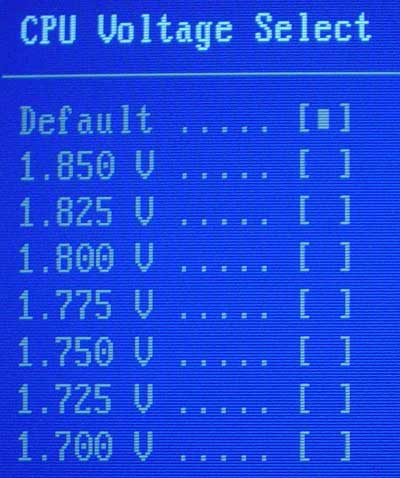
As shown in the picture above, you're allowed to adjust CPU Vcore all the way up to 1.85V in .25V increments. This is fairly high for most overclockers, although not quite enough for the extreme .18-micron Athlon XP overclockers out there. Thoroughbred Athlon XP users might be more satisfied with these Vcore adjustments though.
There are also VDIMM voltage tweaks available up to 2.8V. Normally though,
2.5/2.6V should be fine for your memory, even if you're overclocking fairly
high. For those that plan on doing video card overclocking, there's AGP voltage
adjustments available up to 1.8V, but no other video overclocking options are
present.
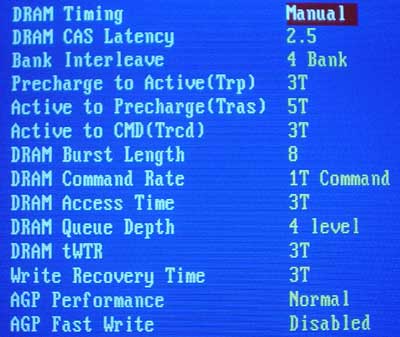
We really appreciate the inclusion of a plethora of memory settings for the KT400 Ultra. Usually dubbed the "Advanced Chipset Features" section, Soyo instead includes a section in the Soyo Combo Menu for "Advanced Tune-up Settings", which allows you to adjust DRAM Timing Mode, CAS Latency, Bank Interleave, Precharge to Active, Active to Precharge, Active to CMD, Command Rate, Queue Depth, and Burst Rate. We are very pleased to see this many memory tweaking options available, and hope to see similar RAM flexibility in future motherboards from now on.

Another nice BIOS feature included with the KT400 Ultra is what Soyo calls their "Anti Burn Regulator." Essentially, the Anti Burn Regulator is supposed to prevent your Athlon XP CPU from overheating if it reaches a certain temperature using the CPU's on-die thermal diode.
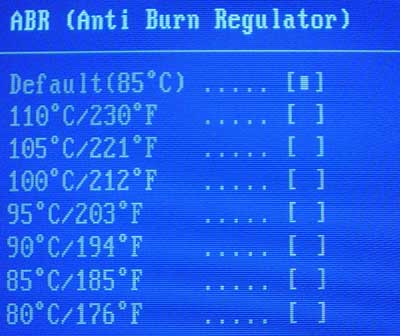
The default cutoff temperature in the BIOS is 85C (185F), however you're allowed to adjust that value anywhere from 50C (122F) to 110C (230F).
For those unlocking their processors, you're given a wide range of multiplier options spanning from 3X to 18X. All the overclocking tests conducted in our labs are done with an unlocked Athlon XP 2000+ (.18-micron Palomino) processor. So for this review, like our ASUS A7V8X and ECS L7VTA reviews, we lowered the CPU's multiplier to see what the Soyo KT400 Ultras' FSB overclocking limit would be.
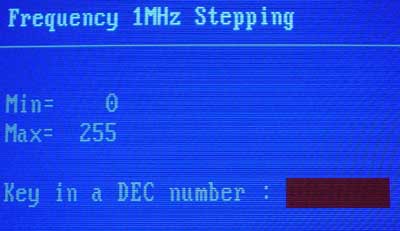
We decided to lower the CPU multiplier from 12.5X to 8X, and see if we could hit 166MHz FSB. Unfortunately, we were only able to hit 153MHz FSB on 1.85V (the max attainable Vcore via BIOS) using a Foxconn heatsink (thermal pad). Knowing this particular cooling setup wasn't all that stellar, we decided to go with a Volcano 7+ with some ASIII thermal compound instead. Using the same Vcore as before, we barely inched up any, hitting just 156MHz FSB.
The purpose of using an unlocked CPU for motherboard reviews is that we can very accurately test the FSB limitation of the motherboard itself, thereby isolating the board instead of the processor or some other piece of hardware. This reason alone is enough to convince us to conduct all our Athlon XP overclocking tests with an unlocked CPU.
Stress Testing the Soyo KT400 Ultra
Overall, we were very impressed with the stability and reliability of the Soyo KT400 Ultra motherboard using different types of memory and hardware configurations.
Looking at the ASUS A7V8X (KT400) and ECS L7VTA (KT400) motherboards, it's clear that DDR400 offers nothing in the way of additional performance. Therefore, it's understandable that some users are indifferent or simply don't care to use DDR400 with any Athlon XP motherboard. However, we believe that with consistent BIOS updates, several KT400 motherboards will eventually show a performance improvement with DDR400 memory versus DDR333. We think this could be the case with Soyo's KT400 Ultra. This motherboard simply performed very poorly with DDR400, which could be blamed on both Soyo and VIA (although Soyo seems to be more at fault here, as you're about to see in our benchmark results). You take a pretty massive performance hit when enabling DDR400 with the KT400 Ultra, so we suggest staying with DDR333 for this motherboard.
This is where the good news comes into play. As you're about to see in our benchmarks shortly, the Soyo KT400 Ultra is more or less the fastest DDR333 Athlon XP motherboard we've tested here at AnandTech using an Athlon XP 2000+ CPU, GeForce4 Ti4600 video card, and Corsair CL2 DDR400 memory. This isn't the fastest (stock) Athlon XP setup in existence, but it puts up some pretty good numbers nonetheless.
However, what's even more impressive about the Soyo KT400 Ultra's DDR333 performance are the memory timings it's able to run at. We tested five different types of memory (Samsung, Kingston, Twinmos, Mushkin, and Corsair) all set to operate at 333MHz. Running our usual set of benchmarks with each memory type, we encountered no stability or reliability issues, and performance was always top-notch compared to competing KT333 and KT400 motherboards. In addition, we were able to run this memory at the fastest timings we've ever seen.
Of course, we then decided to see how well the KT400 Ultra would stand up against
our stress tests by populating all 3 memory slots with DDR333 (we opted to use
high quality memory, and that meant going with 3 sticks of Corsair CL2 DDR400
downclocked to DDR333). Running 3 sticks of CL2 Corsair memory at DDR333, we
were able to achieve the following timings running Prime95 for 24 hours and
rerunning our benchmark suite twice:
|
Stable
Memory Timings |
|
|
Clock
Speed
|
166MHz
|
|
Timing
Mode
|
Turbo
|
|
CAS
Latency
|
2
|
|
Bank
Interleave
|
4-bank
|
|
Precharge
to Active
|
2T
|
|
Active
to Precharge
|
5T
|
|
Active
to CMD
|
2T
|
|
Command
Rate
|
1T
|
These are very impressive timings to say the least. The ECS L7VTA (another solid KT400 motherboard) was able to achieve these same timings using Corsair CL2 DDR400, however bank interleave had to be disabled for the L7VTA to operate flawlessly, whereas the Soyo KT400 Ultra was easily able to handle 4-bank interleave.
Knowing that DDR400 performance took such a huge performance hit, we didn't think it was necessary to even bother running 3 DIMMs of the stuff with the KT400 Ultra. Perhaps Soyo will release a new BIOS that will improve on DDR400 support in some shape or form, but that's just unconfirmed speculation on our part.
The Test
|
Performance Test Configuration |
||
| Processor(s): |
AMD Athlon
XP 2000+
|
|
| RAM: |
256MB Samsung DDR333 CAS2.5 module (M368L3223CTL-C (L) B3)
256MB Mushkin DDR400 CAS2.5 module 256MB Corsair DDR400 CAS2 module |
|
| Hard Drive(s): |
Western Digital 120GB 7200 RPM
Special Edition (8MB Buffer)
|
|
| Bus Master Drivers: |
VIA 4-in-1 4.43
|
|
| Video Card(s): |
ASUS
V8460 Ultra NVIDIA GeForce4 Ti 4600
|
|
| Video Drivers: |
NVIDIA
Detonator 30.82
|
|
| Operation System(s): |
Windows
XP Professional
|
|
| BIOS Version |
1R
|
|
The AnandTech Motherboard Testbed was Sponsored by Newegg. You can buy the components we used to test at www.newegg.com.
Content Creation & General Usage Performance
For our Content Creation & General Usage performance we continue to use SYSMark 2002. The applications benchmarked include:
· Internet Content Generation: Adobe Photoshop® 6.01, Adobe Premiere® 6.0, Microsoft Windows Media Encoder 7.1, Macromedia Dreamweaver 4, and Macromedia Flash 5
· Office Productivity: Microsoft Word 2002, Microsoft Excel 2002, Microsoft PowerPoint 2002, Microsoft Outlook 2002, Microsoft Access 2002, Netscape Communicator® 6.0, Dragon NaturallySpeaking Preferred v.5, WinZip 8.0, and McAfee VirusScan 5.13.
For more information on the methodology and exactly what SYSMark does to generate these performance scores check out BAPCo's SYSMark 2002 Whitepaper.
|
|
Quake III Arena Performance
Quake III's usefulness as a gaming benchmark has diminished mostly because of the fact that we're able to consistently produce frame rates over 300 fps at 1024x768 with the fastest video cards. But as the benchmark becomes less GPU limited, it becomes a perfect candidate for CPU and platform tests such as this one.
|
Unreal Tournament 2003 Performance - High Detail
We introduced the latest Unreal Tournament 2003 benchmark in our GPU Shootout article a few weeks back and we're continuing to use it as an example of a next-generation game test.
|
|
High End Workstation Performance - SPEC Viewperf 7.0
The latest version of SPEC Viewperf proves to be an excellent stress test for memory bandwidth and overall platform performance as you're about to see. The benchmarks included version 7 of the benchmark suite are:
3ds max (3dsmax-01)
Unigraphics (ugs-01)
Pro/Engineer (proe-01)
DesignReview (drv-08)
Data Explorer (dx-07)
Lightscape (light-05)
For more information on the tests run visit SPEC's page on the new Viewperf benchmark.
|
|
|
|
|
|
Final Words
After running a good deal of memory stress tests and performance tests on the Soyo KT400 Ultra, we can say without a doubt that this is a very impressive motherboard (save the DDR400 "issue"). We always like to see a motherboard with lots of features, as it reduces the cost of having to purchase their PCI equivalents, drastically cuts down on case space used, and minimizes complexity in general.
Looking closely at our performance results, it becomes clear that the Soyo KT400 Ultra is the fastest DDR333 Athlon XP motherboard we've tested; it is worth noting that the performance advantage Soyo holds is negligible in real world scenarios however. Unfortunately, it seems as if the Soyo KT400 Ultra will debut for quite a high price; currently, the KT400 Ultra is available for between $175-$200 at no more than a handful of online vendors. This is quite a high price for a single processor motherboard (there are some dual processor motherboards that go for under $200). We would be happier if Soyo brought down the price to around $150, seeing as how there are other KT400 and KT333 motherboards on the market that offer roughly the same performance and feature-set for much much less. However, Soyo says they will be releasing a lower-cost version of this motherboard with fewer bells and whistles in the near future, so we may see a better price/performance board soon enough.
Having tested 3 KT400 motherboards, it's becoming clearer that DDR400 isn't meant for the Athlon platform quite yet. This can be blamed on several factors, including the VIA KT400 chipset itself (which doesn't officially support DDR400), the Athlons' starved 266MHz FSB, or motherboard makers claiming DDR400 support without properly assessing the performance advantages first. Either way you look at it, DDR400 is worthless for Athlon XP users at this time.
Until next time, we hope you enjoyed our coverage of the Soyo KT400 Ultra. Stay tuned for more KT400 reviews, and don't forget about nForce2 either…

